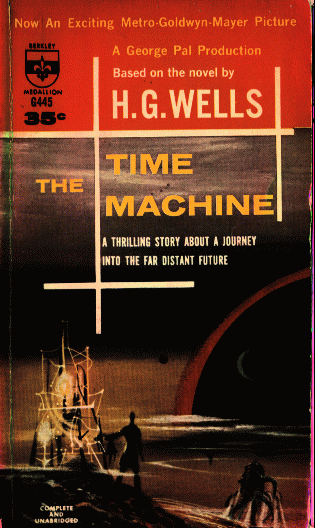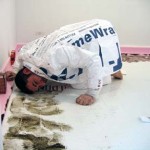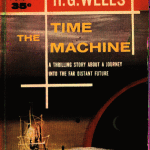"I found the Palace of Green Porcelin, when we approached it about noon, deserted and falling into ruin. Only ragged vestiages of glass remained in its windows, and great sheets of the green facing had fallen away from the corroded metallic framework... The tiled floor was thick with dust, and a remarkable array of miscellaneous objects was shrouded in dust....further in the gallery was the huge skeleton barrel of a Brontosaurus. My museum hypothesis was confirmed."
The Time Machine, H. G. Wells (1895)
It makes perfect sense that in this story, H.G. Wells places the time traveler, humanity’s last scientist and artist, in a vast museum to discover what has survived of human culture in the future. Science and art are both concerned with how we see the world now, while one of the things museums are concerned with is how the world of the future will see the world now. The question always seems to be, “What of today’s culture will make it into the archives of the future?”
I used to work in an astrophysics lab and I remember the first serious experiment that I conducted was a dismal failure. When I showed my results to my mentor, she smiled and said that I had done excellent work. Naturally, I asked her what the hell she was talking about, since I had wasted months of research time and at the end didn’t have a publishable paper. She said, “Oh no, you shouldn’t be upset. 99% of what we do here is a failure. You conduct experiments exactly because you don’t know the outcome will be. By definition, the only experiment that is a waste of time is one where you already know the outcome. It just happens that we only publish the 1% that turn out ok, so it looks like we know what we’re doing.”
I view the art world in the same way. I view galleries as a form of cultural laboratories that are designed to codify and generate values and beliefs. But just like any other laboratory, 99% of what is made is a failure. The artwork that’s up in most galleries is not what I’m interested in. It doesn’t reflect my values and it isn’t changing my beliefs. Many people think that is a bad thing and they spend a lot of time complaining that the vast majority of what they see in galleries is not “good”. But I believe that seeing lots and lots of bad artwork is a healthy sign because if artists aren’t continually making work that is a failure, then they are doing something wrong: they’re not taking enough risk. In my analogy, it would be like scientists conducting experiments they already knew the answers to, and to me, that would be a waste of time. I don’t want to see “good” artwork, I want to see artwork that has the possibility of failing.
Museums, on the other hand, function quite differently. In my analogy, museums function like scientific journals where the 1% of all of the experiments that are successes are the only things that are supposed to appear in it. This notion can be clearly seen in museums like the Louvre, the Museum of Natural History, etc. There are no risks in these museums. Everything you see is “good” as canonized by professional cultural investigators.
The problem occurs when people go to see shows like the Whitney Biennial because the show itself removes the best quality of contemporary artwork, the element of risk. I believe this is the core reason of why so many people have problems with the Biennial. It’s not because of the work. It’s because the work that is selected is in the middle of moving from gallery to museum, from experiment to canon, from having the risk of failure to being “good”.
I have a love/hate relationship with the Biennial because of course I want the artists that I’m interested in to see their work being validated and exposed to a huge audience, but then I shudder to think what would happen if their work lost its edge of risk by someone deeming it “good” artwork. It’s just like the opposing emotions we all have about hoping that our favorite local band will one day receive the global recognition it deserves, but then still privately hoping the band never actually becomes mainstream because then it would suck. I don’t know how I would feel if “Harvey Loves Harvey” was viewed less as underground punk rock and more as mainstream pop rock. However, I am really excited that Andy Mowbray was listed in last weekend’s Sunday Globe article on “10 Artists to Watch”. These are just two local art makers that I love and would have loved to have seen them in the Biennial, but I love their work specifically because it takes massive risks and a show like the Biennial would have robbed them of that power.
So, asking me what I would do if I were in charge of the Whitney is like asking me what I would do if I were in charge of a massive, mainstream underground punk rock music festival. I would dismantle the whole thing because it doesn’t make any sense. The Whitney Museum, by definition, is filled with “good” artwork, but the flipside of that coin is that it will never have any great artwork. So instead, I say let’s just go out in droves and support our local artists and our local community because that’s where the risks are being taken and subsequently, that’s where the really great work is.
Links:
Whitney Biennial 2006 - Day for Night
Andrew Mowbray
"Whitney Biennial 2006 - Day for Night" is on view at the Whitney Museum of Art located at Madison Ave. and 75th St. in New York City.
All images are courtesy of the artists and Berkley Publishing.







